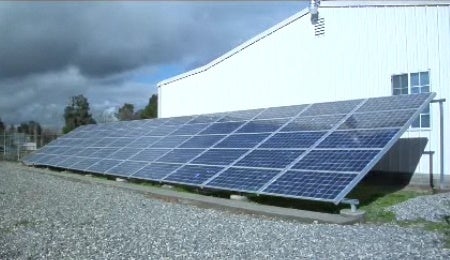New Report on Innovative Green Business Solutions
 This post is by Sheryl Canter, an online writer and editorial manager at Environmental Defense Fund.
This post is by Sheryl Canter, an online writer and editorial manager at Environmental Defense Fund.
Ideas for businesses, and hope for everyone concerned about global warming – that’s what you get with our just-published, first annual Innovations Review. This new report highlights innovative processes, products, and technologies in a range of different industries.
Green business practices can drive cost savings and create new markets, giving companies a competitive advantage. But what’s next after the basics, like switching to energy-saving light bulbs and printing double-sided?
Here’s one example that caught my eye – a southern California Web hosting company powered entirely by the Sun.

All server farms must be kept cool. In fact, the average data center is 40 times more energy intensive than an office building. For Affordable Internet Services Online (AISO) , which is in the desert, cooling is a particular challenge. But AISO is able to meet 100 percent of its power needs – for both its office and server farm – from 120 solar panels.
How is this possible? The answer lies in a combination of efficient design and innovative technology. For example, the AISO facility features:
- A unique air cooling system blows in cool air from outside when the temperature drops below 50°F (as often happens at night).
- Twelve-inch walls with high-grade insulation.
- Servers running at 75 percent capacity – compared to the usual 10 percent – thanks to virtualization software that lets one server host multiple applications.
The data center cost 60 percent more to build than a standard site. But AISO saves $3,000 a month in utility bills, and its environmentally responsible business practices have attracted a fast-growing client base.
In short, the company’s investment is rapidly paying off.
Check out the full report for examples of other innovative business practices in real estate, manufacturing, fleet management, finance, and more.













6 Comments
Great idea. How long do you think it will be until we can get a solar panel sufficient enough to heat and cool our entire home, not needing to be on the electric grid at all? I’d be the first to get one.
Many people are doing this already. I’ve ready about systems that sell power back to the grid during peak times. The main impediment for most people is the initial cost. There are some incentive programs to make this easier on people, but not enough yet.
It also helps to live in a sunny climate, I would think. I’m in the southern plains of the U.S. and there isn’t much sunlight, in the winter months especially. Our next house will definitely have at least one room powered by solar panels.
If the oil companies could make a profit on solar that’s as much as on oil, we’d be in business. Using that scenerio, we’d be paying almost as much as for coal-powered generation, but the greehouse gases would be almost none. Those companies could use solar power to send through the grid instead of coal powered generation.
One of the things that really appeals to me about green building is that it works WITH the environment rather than AGAINST it. From our “Green Buildings” post:
“How do you make a building green? Well, it depends on where it is. If it’s a place that gets a lot of sun, solar energy might work. If it’s a windy locale, wind turbines might be the better choice. Glass, no glass, windows facing the sun or not – these are all decisions that depend on the environment in which you’re building. Standard buildings impose their artificially created climate on their environment. Green buildings work with the environment, rather than fighting against it.”
McElroy metal roofing offers a ‘Green roof solution’ with Unisolar thin film solar PVs. They take a further advantage of low light, cloudy light, and winter light. Check it out online, because the roofing+solar package is pretty easy installation, you simply put up the metal panels, clip into place, and connect two cables at the top on each metal panel and cover with the ridge cap. Probably the best total system I’ve seen in our architecture firm…
Ecological responsbility does not occur merely by switching from non-renewable energy sources to renewable ones. We also have to be aware of how green such systems–especially PV panels for solar–actually are. For example, a common manufacturing component of solar cells is comprised of gallium arsenide. From a toxicological perspective, this element, because of its arsenic content, is considered highly toxic and carcinogenic.